|
|
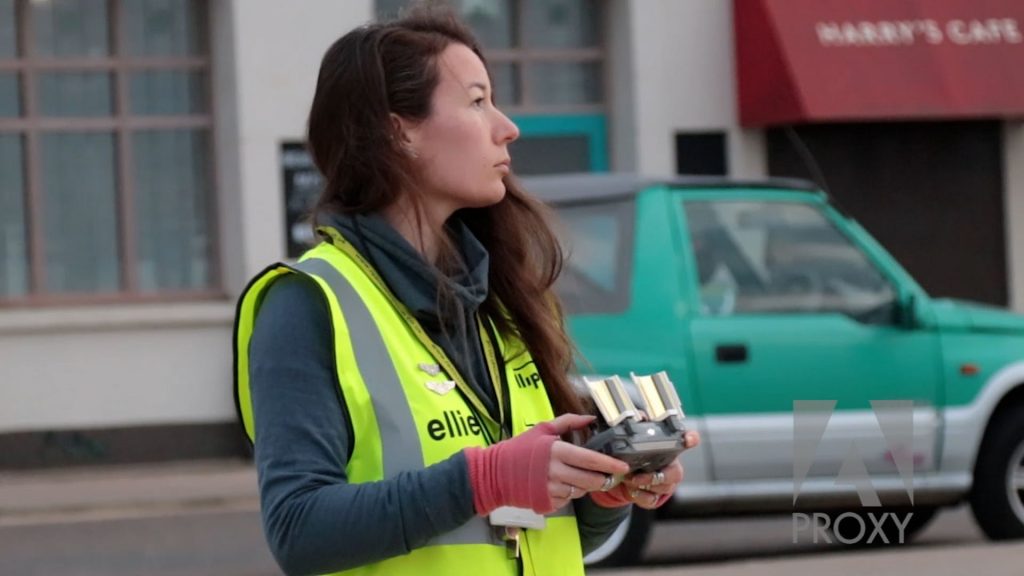 Ellie Mackay, Ellipsis Earth CEO, flying drone – photo: Ellipsis Earth The most scientifically robust litter survey ever undertaken in the UK has revealed that positive, playful environmental messaging can cut litter and reduce plastic pollution. By creating bins that had positive, engaging messaging and strategically placing them in litter hotspots a 75% decrease in littering was achieved. In contrast negative and hectoring messaging increased littering by 10%.
The pioneering use of drone and AI technology was led by scientists at Ellipsis Earth. They undertook three sets of drone flights over Bournemouth, Christchurch and Poole creating a detailed map of every bit of litter dropped in the surveyed areas including beaches, town centres and green spaces. Surveys took place during the March lockdown, over the late May Bank Holiday weekend and finally during August Bank Holiday weekend.
The charity Hubbub used the data collected in May to implement a range of anti-littering campaigns built around proven behaviour change campaigns. In parallel the council ran their traditional communication campaign with more aggressive messaging. Results were measured by the August survey.
The interventions that proved most successful with residents and visitors in Bournemouth were the glow-in-the-dark bins, which saw an 88% reduction of glass bottle and aluminium cans littered in the vicinity, and ballot bins, where an average reduction of 73% of cigarette butts was recorded, when placed in targeted locations.
Other findings from the trial, revealed:
- The east side of Bournemouth Pier (where multiple interventions were placed) saw a reduction in litter of 79%. The west side (where no interventions were placed) had zero reduction
- Large brightly coloured bins helped reduce litter in Bournemouth Lower Gardens by 89% when they were brought in to supplement existing small closed bins which had previously been the worst performing bins in the region
- Ballot bins attached to lampposts (where people answer a question by depositing their cigarette end) placed in targeted locations showed an average reduction of 73% of cigarette butt litter
- All other existing council bins across Bournemouth and Poole showed no decrease in litter
- In Christchurch and in all the other beaches in the area where no interventions were put in place there was also no decrease.
Where negative and accusatory messaging was used, there was a 10% increase in litter in areas near this signage, suggesting that negative messaging doesn’t prompt positive behaviour.
The data also indicated that a fundamental change in strategy is required to cut plastic pollution reaching the sea. One of the largest forms of littering were small plastic fragments. Food outlets along the Bournemouth beachfront sell takeaway food in disposable polystyrene containers. Many are left on the beach to be pounced upon by seagulls searching for food scraps. The containers break into tiny plastic fragments which are blown or washed into the sea. This type of pollution would be ended if outlets were obliged to use reusable containers with a deposit repayable when returned. The solution exists but policy leadership by the council is required to make it happen.
The data illustrated that a surprising number of beach toys such as buckets, spades and inflatables were left littered on the beach. These are relatively cheap and can be cumbersome to carry so clearly some people think they are not worth the effort of removing. A solution might be to create a rental service for these items on the beach front. Not only could this cut littering it would also reduce the hassle of buying and lugging awkward items around which are only used infrequently.
Bournemouth rightly prides itself on world class beaches. The pristine sand is cleaned early every morning before visitors arrive. However, significant levels of litter are dropped in the late evening by people partying on the beach. Invariably this litter is washed into the sea before the early morning clean. Shifting cleaning routines to just before High Tide would prevent plastics reaching the sea. This is harder for the council to organise and potentially more expensive, but currently they are allowing the problems to be literally washed away.
Above everything, the campaign illustrated the significant value of high-quality data to inform decision-making. Based on the information provided councils could create more focussed litter prevention strategies, place bins where they are most needed, refine messaging in hot-spot areas, target resources more efficiently and work more closely to reduce littering.
By Chris Hampton, Product and Business Development Manager – Hydrogen, at BOC UK & Ireland
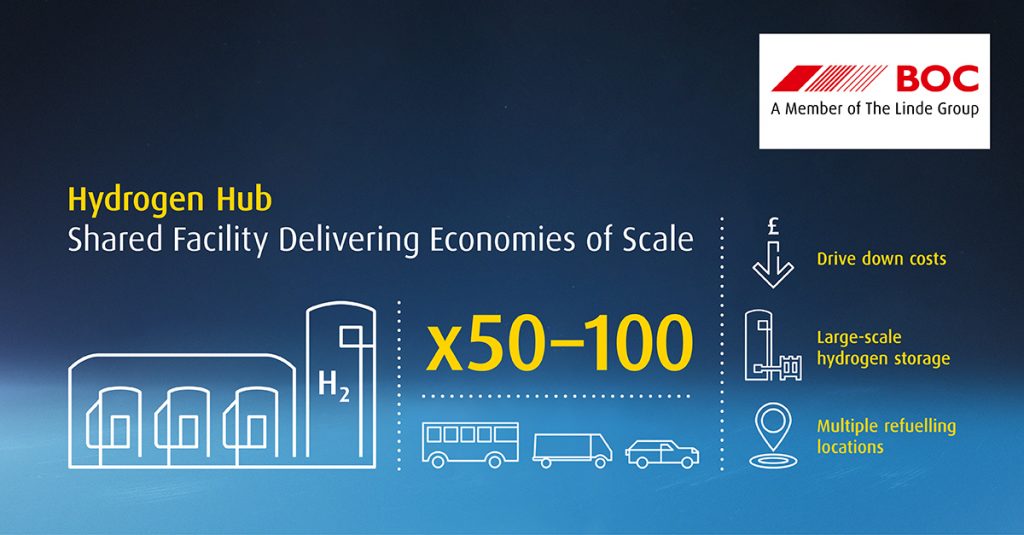 Council Guide to H2 Councils and local transport authorities (LTAs) are well-positioned to take a leading role in de-carbonising the UK’s transport system. By updating transport fleets to use zero emissions vehicles, councils can lead by example and, even more importantly, put the infrastructure in place to enable others to follow suit. Councils and LTAs should carefully consider their options for decarbonising transport. The decisions they make today could affect the choices available to other fleet operators tomorrow.
Where to start?
‘Where to start?’ is one of the most common questions asked by councils and LTAs. To answer that and more, we’ve compiled a simple guide, available here: BOC’s Guide to Decarbonising Transport with Hydrogen Hubs.
The hydrogen advantage
Hydrogen fuel cell vehicles offer some key advantages over battery electric vehicles. They offer a fast and familiar refuelling process, which is comparable to today’s petrol and diesel vehicles. Hydrogen vehicles also offer good range (typically 350-500km) from a single refuelling. A further benefit is that hydrogen suits big and heavy vehicles that would otherwise require heavy batteries to power them. These characteristics make hydrogen an ideal fuel for buses, refuse trucks, road sweepers, gritter lorries, delivery vans and other vehicles in daily use with the ability to return to base for refuelling. All of these vehicle types are running on hydrogen today.
From small to large scale
BOC offers modular refuelling stations that enable customers to start small and grow their infrastructure with increasing demand. If you operate a small fleet of vehicles but you want to benefit from the economies of scale that come with producing higher volumes of hydrogen, BOC can help you join forces with other users to build a shared refuelling facility with a larger vehicle usage. Scaling up can dramatically reduce the price of hydrogen.
Hydrogen is a strategic focus for the UK government and as a result there are a range of funding sources available to help finance your project. BOC is also able to help finance the capital cost for high-volume refuelling hubs.
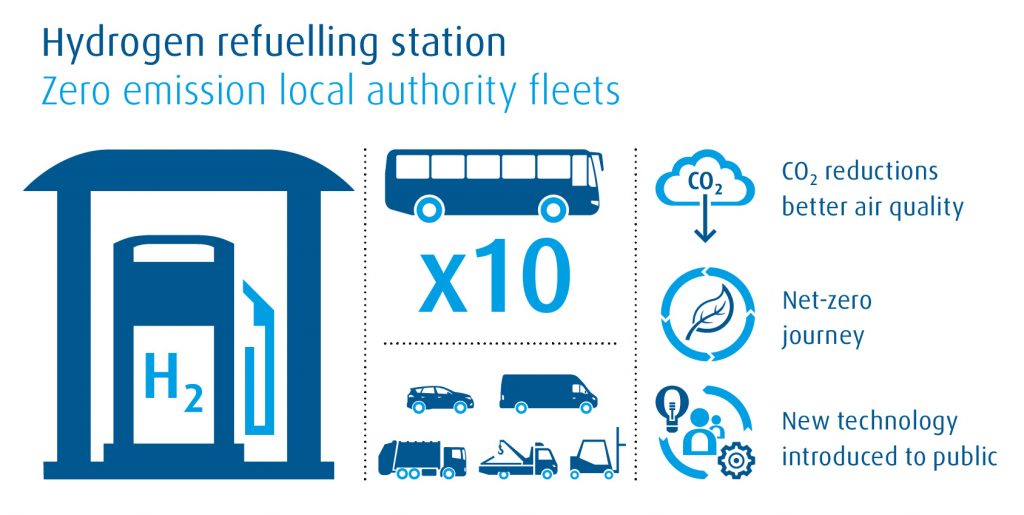 Hydrogen Refuelling Station Location
As well as having a location for vehicles to access dispensing pumps, a refuelling station will need space to store the hydrogen and an electrolyser to produce it. However, the area needed is typically no bigger than a traditional petrol forecourt. Layouts can be designed to fit almost any space and sites can be safely located adjacent to residential areas, if required.
Green hydrogen
To produce green hydrogen, you need renewable energy. BOC works with customers to source renewable power from a suitable supplier.
Safety
Hydrogen refuelling stations are safe. You must of course ensure appropriate safety distances from nearby assets, but this can be calculated and built into the engineering design. Hydrogen storage vessels are purpose built and designed to maintain pressures at optimal, safe levels and pumps are designed to ensure a safe connection between the dispenser and vehicle – with effective system safety checks every time hydrogen is dispensed. BOC has been producing hydrogen for over 100 years and it’s parent company, the Linde Group, has designed and installed over 200 hydrogen refuelling stations worldwide.
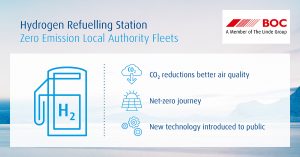 Timescales Timescales
Typical total build time is around 15-18 months. This allows for planning permission, civil engineering works, construction and commissioning.
Demonstrating success
When Aberdeen City Council wanted to develop a cleaner public transport network, it worked with BOC to develop, install and operate a tailored, state-of-the-art hydrogen refuelling station. The facility, based at the Kittybrewster bus depot, produces green hydrogen from electrolysis on site, and supplies a fleet of buses that travel up to 350km each day. Kittybrewster is now accessible to all hydrogen-fuelled vehicles, including double decker buses and private vehicles.
Moving forward
Opting for hydrogen refuelling to decarbonise your transport fleets is simpler than you think. By putting modular infrastructure in place it’s possible to scale up, share costs and help other fleet operators decarbonise their vehicles too. The first step is to find the right partner. A good hydrogen fuel specialist should be able to manage the whole project, from assessing specific transport and infrastructure needs to advising on funding, design and development of the facility. It could even operate and maintain it for you.
If you’d like to find out more you might find BOC’s guide to Decarbonising Transport with Hydrogen Hubs a useful resource. It contains all the information in this article – and more – in a handy PDF format.
 Vicki Dunn Energy Assets Networks & Pipelines, a leader in final mile gas and electricity network adoption, ownership and management, has appointed a new Business Development Manager covering the north of England and Scotland.
Vicki Dunn, from Tadcaster near York, joins EAN/P with strong industry experience, having previously worked for companies involved in utilities construction.
In her new role, Vicki will be developing new business relationships with independent connection providers (ICPs) and working alongside existing EAN/P customers to help them optimise the asset value of their energy network construction projects, whether for residential housing or industrial and commercial developments.
Said Vicki: “I’m really pleased to be joining EAN/P at such an exciting time in the company’s development. It’s an area of the energy market I find really interesting and with the national focus on increasing housing provision, there are lots of opportunities opening up.
“I’ve had many job roles in my career, but business development is something I really enjoy because it involves working alongside customers to overcome challenges to help them deliver their projects. I also think my experience working for ICPs will add value to our proposition.”
Vicki is joining one of Britain’s fastest growing and most innovative local network ownership and management businesses. In addition to providing a flexible approach to asset adoption, EAN/P has also invested heavily in in-house technical, legal and administrative expertise to support the work of contractors, housebuilders and industrial and commercial developers.
This includes the launch of the Milestone Legal Progress Tracker, the first online project administration and customer communication portal of its kind in the connections industry, enabling clients to see the status of their projects at a glance, at any time.
The company is also a leading player in the development of Britain’s EV charging network, working alongside companies such as InstaVolt and MFG to help expand the country’s charging capacity.
www.energyassetsnetworks.co.uk/
 Annie Rickard – Managing Partner of OOH Capital Every day articles are published about what a city should be. At the same time, there is much discussion around the way people’s work habits have changed because of the pandemic and the impact remote working is having on city environments.
Whether it’s a one-minute city or a fifteen-minute city, or some other city, they will all have one thing in common. Things have changed and, as stated in the latest Global City Report from management consultancy A T Kearney, city planners must ‘re-imagine city planning in a way that makes the lived environment more sustainable, resilient and inclusive’.
One asset that is often overlooked or undervalued in this equation is urban media: communication in public spaces. This is also commonly known as Out of Home Media.
Most cities and municipalities around the world already derive valuable revenue share income from Urban Media. And additionally mobilise valuable free public messaging campaigns through their Out of Home media estates, with posters and digital screens that are tastefully incorporated in bus shelters, on public land and in public transport networks, providing important civic and safety information, that reach and impact their citizens when they are away from home, engaged in the activities of daily life.
And the income can be significant. It is estimated that a large proportion of revenues generated through Out of Home advertising ends up in city treasuries, through revenue sharing agreements with Operators. But can city authorities achieve more, by revving-up their revenues from urban media and unlocking the hidden value residing in these often-underexploited estates?
Cities have long accessed these benefits through varied webs of commercial partnerships with Out of Home Operators that offer, through these urban media facilities, a vast spectrum of civic amenities and other essential community services.
They range from bus shelters, public toilets and way-finding signage to providing a medium for public messaging, a service that has been much utilised by authorities during the Covid pandemic.
And these Urban Media Operators offer services that maximise incremental income potential while providing the next-generation amenities that enable convenience and promote community pride.
However, many of these commercial partnerships have been negotiated at different times over long time spans, that were codified before the introduction of today’s cutting-edge technologies, which means that cities may not be fully aligned with the needs of 21st century communities and their citizens.
It’s time for cities to optimize their existing and future urban media programmes by rationalising and streamlining commercial relationships and investigating the financial and community benefits that the latest technologies afford. This will allow cities to leverage the potential of innovation and digital integration.
By reviewing and improving how they manage their urban estates, cities and municipalities can introduce new revenue streams, enhanced civic communications, and deliver an improved carbon footprint, all the while building better municipal services including data integration, security solutions and maintenance assistance.
And urban media, with its financial contributions and innovative ways of providing public amenities, can make a great contribution to the process of financing new ideas and making public spaces more useful, attractive and friendlier environments.
Annie Rickard is Managing Partner of OOH Capital
OOH Capital is the complete consultancy for a time when technology is transforming urban media. OOH Capital helps clients, ranging from cities and municipalities to brands and businesses, realize value from the limitless potential urban media provides. The partners at OOH Capital have a combine experience covering more than 75 countries and are well-equipped to advise on a global scale. OOH Capital provides expert knowledge from assessment and evaluation, through to strategy, deployment and finally delivery. More information is available at www.oohcapital.com
Leading shared care record and population health management provider to become ‘quality partner’ and early adopter for assessment against the core information standard
Move demonstrates Orion Health’s commitment to open systems and standards that will guide the development of shared care records in England
Orion Health is supporting the Professional Record Standards Body’s partnership scheme by applying to become a ‘quality partner’.
The company, which is one of the UK’s leading providers of shared care records and population health management systems, will work with the PRSB to develop the ‘core information standard’ and its assessment process.
The ‘core information standard’ is critical because it underpins the NHS’ drive to make sure that every integrated care system has a ‘basic’ shared care record in place and is ready to develop a ‘comprehensive’ shared care record by 2024.
 Nadine Carey-Whitehead, sales director of Orion Health in the UK Orion Health will also be assessed against the PRSB’s ‘document naming’ standard as part of its support for the partnership scheme, which has been set-up to recognise healthcare IT vendors with a strong commitment to best practice.
Nadine Carey-Whitehead, sales director at Orion Health, said: “Open standards are core to what we do at Orion Health. Without them, it is incredibly difficult to gather and make sense of all the data that needs to go into a shared care record from across the health and care sector, so we are always looking out for ways to support their development and adoption.
“We have said that we will help the PRSB to develop its core information standard and the process for assessing companies against it in any way that we can. As a market leader, we have the benefit of having a product in use on the ground that already exceeds the requirements of the ‘basic’ shared care record.
“However, we want other companies to be using this standard and for customers to be asking them to do that. If everybody uses standards, it supports the production of high quality information and the whole industry moves forward. We can all get the ‘basic’ shared care record done and move onto other things that will benefit the system, clinicians and patients.”
The PRSB helps to develop and implement standards for the structure and content of health and social care records and is looking to become the “authoritative voice” on what constitutes a high-quality electronic record.
It set up the partnership scheme earlier this year, to create an alliance with the health and tech sector and to recognise vendors committed to best practice.
Companies can join at two levels: as a partner, to demonstrate their commitment to standards; and as a quality partner, to demonstrate that they are meeting one or more standards.
Lorraine Foley, chief executive of the PRSB, said she was delighted to have Orion Health on board. “The intention of our partnership scheme is to move everybody forward by getting the standards that we have developed adopted and used,” she said.
“At the heart of being a quality partner is an assessment of compliance with one or more standards and Orion Health has agreed to become an early adopter of the ‘core information standard’, which underpins shared care records.
“It is different from some of the standards we have developed, because it is a collection of data items that can be used at many points in the patient journey, so the question of whether it has been met or not is going to be nuanced.
“We will work with Orion Health and others to come up with a sensible assessment process that will deliver meaningful results.”
The PRSB and Orion Health are keen for more suppliers to join the partnership scheme. Foley said vendors welcomed the opportunity to work with its experts and clinical teams on standards specifications, while the PRSB benefited from input on how the standards could be adapted to work better in practice.
 However, the PRSB is also looking at how it can include NHS providers, to create a “gravitational pull” for making open standards a requirement in systems procurements and deployments. However, the PRSB is also looking at how it can include NHS providers, to create a “gravitational pull” for making open standards a requirement in systems procurements and deployments.
“What we want is the PRSB, vendors, and providers all pulling in the same direction, to create better records that will support more efficient, better care,” she said.
Carey-Whitehead agreed – and argued that the development and deployment of open standards will be particularly important as the NHS looks to adopt new digital ways of working as it repairs and resets after the pandemic.
“COVID-19 highlighted not just the necessity for, but also the benefits of a shared care record. It taught us that we need to do things differently, but we need to do them in a standardised way.”
By Scott MacIndeor, water and sustainability lead and Head of Advanced Services, Water Plus
Public Sector organisations have a great opportunity currently to give a boost to budgeting, lower impacts on the environment – and get ahead of the curve for future legislation. It’s down to the water that’s flowing through the taps, showers and toilets on-site and harnessing people power to cut water waste, and – ultimately – lower the utility costs, including energy.
September onwards is an important time for many in the public sector with budget setting meetings in councils and new financial years getting underway for others, like schools and universities.
Looking closer at water – and how it’s used – can pay back organisations quickly, reduce risks to keep doors open and facilities functioning and cut the amount of carbon being created. And your staff want to help you with this.
How people power and data in the public sector can help
Research shows over half of public sector employees cut their water use at home because they are concerned about their impact on the environment and believe their employers could do more to encourage a reduction in water use at work*. The insight in the survey, published here, provides a window into the views of staff to help those managing facilities.
And an Acute Hospital in England that had data loggers installed this year on water meters, found the extra, daily information on water use through an online smart portal is helping with their financial planning including budgeting and forecasting, as well as identifying opportunities for water efficiency steps.
 Scott MacIndeor, Head of Advanced Services at Water Plus, said: “Many sites in the UK public sector and other industries will have seen changes in the amount of water they’re using since March 2020 – and this could still vary considerably in the months and year ahead with current working patterns and the numbers of those using facilities. Although water can be an afterthought for many organisations, it can be an untapped source for saving and has the power to deliver wider benefits where it’s used more effectively – including lower energy costs as hot water use decreases. Scott MacIndeor, Head of Advanced Services at Water Plus, said: “Many sites in the UK public sector and other industries will have seen changes in the amount of water they’re using since March 2020 – and this could still vary considerably in the months and year ahead with current working patterns and the numbers of those using facilities. Although water can be an afterthought for many organisations, it can be an untapped source for saving and has the power to deliver wider benefits where it’s used more effectively – including lower energy costs as hot water use decreases.
“Sites with just one, or a few water meters can also benefit from noting meter readings each month, if the meter is safe to access. Knowing what you’re using, where – and when – helps you spot any issues early that may cause disruption. Plus, where less water is used and where water waste reduces, it means less carbon created, so less Scope 3 emissions, helping towards environmental climate targets and Net Zero.”
September 2021 also saw the latest water factsheet briefing note for the Environment Bill**, which included information around building standards and local authorities being encouraged to introduce minimum standards on how much water each person uses each day at sites.
The sense in site checks
Regular servicing and maintenance of taps, toilets and urinals – as well as any water efficiency devices in buildings – is important – so you know they’re working properly and no water’s being wasted.
- Carrying out site checks regularly is also worth the time. A council that had data loggers installed this year was alerted to a Town Hall that had water leaks losing 200 litres of water an hour. If these leaks continued for a year it would cost more than £5,200. Another site also had 100 litres of water an hour being lost.
Also, in the last 12 months, a High School with a leak in a plant room at their site – was losing an estimated 12,000 litres (12 cubic metres) an hour, at an estimated cost of £850 a day – caused by a copper pipe that had corroded. The leak was causing some flooding in the plant room so needed quick action. Water Plus provided a quote for its repair experts to attend and complete work on-site and the leak was fixed the following day.
- Keep an eye on the weather and take steps to be ready for colder months. Make sure your employees know what to do if they see a leak and how they can report faults like running taps. Review your plans so you know where you’d get extra water if needed and keep updated on weather alerts for where your locations.
Partner with experts to harness water’s full power
Water Plus is the largest water retailer in the UK and manages the water and wastewater services for many public sector organisations, including some of the largest and most diverse in England and Scotland – from councils, schools, colleges and universities, to UK Government-owned sites, prisons, hospitals and the emergency services.
Water Plus also has a unique weather alert tool, which some multi-sites are currently using, to help manage risks and impacts from this on sites.
Get in touch about what can be achieved with your water by contacting their team at hello@water-plus.co.uk
** September 2021 update water factsheet: www.gov.uk/government/publications/environment-bill-2020/10-march-2020-water-factsheet-part-5#further-information
by Richard Walker, Data and Insights Partner, Agilisys
Over the past 12 months we have frequently heard the Prime Minister declare that Government is “following the science”. At the same time, millions of us have found ourselves staring at charts and monitoring trends eager to understand the current situation. The link between the data that government collects and the outcomes it drives has suddenly assumed a place at the forefront of public consciousness. While the concept of data saving lives has perhaps never felt more prescient, it is not only in times of unprecedented uncertainty that the value in public sector data comes to the fore.
 Richard Walker There are pressing questions for the public sector that will continue to challenge even after the threat of the pandemic diminishes. How do we deliver better care for an ageing population with changing needs? How do we predict and prevent threats to public safety? How do we move around the country more efficiently? And, how do we stop the damage we are doing to our environment? Data will help provide the answers.
Providing a return on investment of data
Budgets are not endless. The difficulty in proving return on data investment is probably the number one reason to get serious about defining and measuring the value in your data, but it is not alone.
1.Not all data is equal
When choosing which elements of a data strategy to invest in, choices need to be made. These should be informed by the value each initiative will individually or collectively unlock.
The answer for which actions to prioritise should lie in a clear understanding of the route to value. Not all data is equal when it comes to delivering your strategic objectives, you will need to prioritise and be able to defend those decisions to those who would have preferred you start with their area instead.
2.A need for clarity
Like everyone else, us data folk should be held to account for the investments that are made in improving data itself (collection, curation, quality etc.) or the methods used to extract its value (analytics, digital applications etc.).
Without a baseline of the value in data, how can public sector organisations present a case for the improvements that have been made over time? The answer is they cannot. Therefore, providing a clear need to value their data assets and revisit those valuations over time.
3.Ensuring a fair price
It may be an uncomfortable concept, but the world’s wealthiest companies are data companies. Make no mistake, the value in public sector data assets to those companies is monumental. It is data they can only approximate from all the other sources they mine.
In a hypothetical scenario whereby a local or regional authority were to look to monetise its data, you would want a fair price, to be assured that value is fully understood, and the best deal negotiated. This will not happen without measuring value.
How can a value be put on public sector data?
1.Cost Value of Data
Collecting, managing, protecting and storing data all costs money. When you factor in the people and technology elements, it only increases. Working out how much your organisation currently spends looking after data is a good starting point for future negotiations.
Presenting your plan as an incremental investment (often a small percentage) to get better bang for the significant buck already committed, is a technique frequently used by those responsible for other strategic assets. The sell can take many forms, it might be that you will drive process efficiencies or performance improvements elsewhere in the organisation, or that you can identify savings and efficiencies within the current data spend portfolio but need to land an invest to save proposition.
2.Economic Value of Data
 The economic value is the difference between costs and benefits. Applying a framework to a data related initiative is often difficult. In commercial settings, it can be achieved through testing e.g. make data available to sales team ‘A’ through a new BI platform but not to sales team ‘B’ — measure the difference in performance and you have a measure of value returned for your investment. The economic value is the difference between costs and benefits. Applying a framework to a data related initiative is often difficult. In commercial settings, it can be achieved through testing e.g. make data available to sales team ‘A’ through a new BI platform but not to sales team ‘B’ — measure the difference in performance and you have a measure of value returned for your investment.
When we do this with government organisations, we tend to look at unit costs as being the most effective scaling factor for the benefits unlocked. I was part of a project a few years ago where the client had an issue with delayed transfers of care from an acute hospital setting into community settings. Neither party in the discharge process had visibility of the other’s data. Acute settings did not know when spaces would become available to discharge patients into, and brokerage teams had no advance view of how many patients with which types of need they were going to need to support.
The intervention was to create a live link between two systems to facilitate the exchange of data; a portal to view it through and engage the respective teams to ensure that relevant data protection principles were considered. The inputs (both data and technological), activities (drafting and reviewing a DPIA, configuring and testing the live link, designing, and building the portal) formed the costs (c£100k). The outputs, e.g., improved patient health outcomes, reduced incidents of delays in transfer of care and improved staff morale were some of the benefits. In total, conservative efforts suggested the trust was able to save £150,000 per month in bed days. This is a powerful example of how investing in a data and insights project effectively could yield real tangible and positive impacts.
3.Opportunity Cost Value of Data
The cost of unrealised value due to the “state” of the data asset can be measured using the opportunity cost of investments already made or outcomes not achieved.
Imagine your organisation has made a £20m investment in a new technology platform. You were persuaded to go for the market leader, reassured that concerns over legacy platforms were nothing the vendor had not seen before and that its solution would fix all of that anyway. Two years in and only 60% of the functionality has been enabled. Your vendor is blaming the state of your data. The state of your data is therefore costing you £8m.
4.Market Value
There are many partnerships being struck right now around innovative new technologies between public and private sectors. Often the public sector provides the data whilst the private sector provides the means to turn it into insight and action. I believe we will see more and more of this type of “joint venture” going forwards and we will very quickly come to think of public sector data as a magnet to pull in private sector investment.
Data is not finite and so the opportunity to repeatedly sweat the same asset through such deals is much greater. Not forgetting legitimate concerns around the ethics of using government data in this way, but there are ways to navigate those and end up at this reality sooner than we think.
However, these approaches are not designed to be mutually exclusive. To go toe-to-toe with other investment priorities, you will probably need as much ammunition as you can muster. It is vital, therefore, that in prepping yourself to cross the final hurdle to secure funding, you do not overlook the power in the human outcomes you plan to drive, be that better care, safer communities, or a cleaner environment.
Marry the two, though, and you should have a winning formula.
 Newham Borough Council is a vibrant Council bordering the City of London, most of its residents are from ethnic minority backgrounds and cumulatively speak more than 100 languages. Newham’s leadership team is constantly looking for ways to provide the best for its citizens. Introducing intelligent chatbots to its parking customer service offering is an important example of how the council is making a difference through technology. Newham Borough Council is a vibrant Council bordering the City of London, most of its residents are from ethnic minority backgrounds and cumulatively speak more than 100 languages. Newham’s leadership team is constantly looking for ways to provide the best for its citizens. Introducing intelligent chatbots to its parking customer service offering is an important example of how the council is making a difference through technology.
With demands for council customer services ever increasing, Newham Council wanted to use the chatbot software to help streamline frequently asked questions to free up employee time to work on the more complex queries.
Ron Springer, Head of Customer Services said,” We receive in excess of 400,000 calls to the council contact centre every year – with a huge number of them being common questions.”
In particular, the council felt that parking calls could be triaged using chatbots, so that high priority calls could be dealt with by staff. The team also wanted a system that could provide real-time feedback so that common problems (as well as successes) could be identified to further improve customer services.
This led Newham’s digital transformation team to Futr AI, the leading public and social services chatbot software developer and integrator delivering superpowers to critical service teams to be the best they can be. From out-of-hours self-serve chatbots on any channel, to making live chat agents instantly multilingual in over 100 languages, Futr’s superpowers are transforming the way organisations serve their audiences.
The Newham team found the software easy to install and once the FAQs for parking with appropriate answers were in place, the chatbots were able to manage calls very smoothly, pushing the critical ones to council call centre staff.
Within the first six months of deployment, data showed that the council had saved 84 hours of call time and that the chatbots had answered 10,491 non urgent and repeat questions, saving the council about £40,000.
Not only did the chatbots assist with call volumes and time saved but also its multi-national language capabilities enabled queries to be answered in 23 different languages fluently. The ability to keep the chatbots on all day meant that customers had access to council parking services 24/7, allowing access to information at times convenient to them.
The digital transformation team have access to the real time data at any time and are able to analyse which problems their parking customers are experiencing the most, helping them to further tailor services to their customers’ needs.
A very delighted Ikramul Haque, Head of the Council’s Digital Transformation remarked, “Setting up Futr’s chatbots was one of the easiest integrations we’ve done. It arrived ready for use out of the box – deployment was as simple as a few clicks.”
Not only has the Council found that it is achieving better accessibility for customers, costs savings, enhanced customer services teams capacity, it has also given them the superpowers to engage fluently in over 100 languages seamlessly across various platforms – the website, email or other applications like WhatsApp.
Ron Springer added, “Faced with increasing demand and channel shift, Futr’s chatbot is future-proofing our service delivery and giving our call centre the bandwidth to deal with more complex issues.”
Futr has over 1,000 organisation customers around the world and continues to enable customer services teams to deliver critical services to communities. For more information go to www.Futr.ai
DSEI, 14 – 17 September, 2021, ExCeL, London, Stand No: H1-450
Armour Comms will be showcasing several new capabilities of its OFFICIAL-SENSITIVE, NATO approved Armour® Mobile at DSEI, including a technical preview of its secure collaboration solution, Unity by Armour. Other innovations on show will be Armour’s work with the Ministry of Defence (MOD) for secure mobile comms which is currently being successfully deployed across several operational areas to replace use of consumer grade apps; and Armour’s unique technology for Bittium devices, which enables users of Bittium’s Android TM2 solution to communicate without using the public internet.
 Unity by Armour works in conjunction with Armour Mobile extending its secure collaboration capabilities with secure video conferencing calls (pre-defined or on-the-fly), screen sharing and integration with secure chat groups, in addition to the existing one-to-one secure audio and video calling, and interconnectivity with trusted unified communications systems. Unity by Armour provides picture in picture and multiple screens, and offers a familiar video conferencing interface, making it easy and intuitive to use. Unity by Armour is available with a choice of hosting options, including on-premises installation, ensuring that communities are controlled by invitation-only, increasing security and guarding against ‘zoom-bombing’. Unity by Armour works in conjunction with Armour Mobile extending its secure collaboration capabilities with secure video conferencing calls (pre-defined or on-the-fly), screen sharing and integration with secure chat groups, in addition to the existing one-to-one secure audio and video calling, and interconnectivity with trusted unified communications systems. Unity by Armour provides picture in picture and multiple screens, and offers a familiar video conferencing interface, making it easy and intuitive to use. Unity by Armour is available with a choice of hosting options, including on-premises installation, ensuring that communities are controlled by invitation-only, increasing security and guarding against ‘zoom-bombing’.
Armour Comms will also be showcasing the latest innovation for its NATO approved secure communications solution which now includes unique Secure Push technology from Bittium. This feature allows secure and battery efficient signalling of incoming Armour Mobile calls and messages also in classified networks that do not have connectivity to public Internet.
 Armour Mobile runs on Bittium’s Tough Mobile™ 2 series of ruggedised and secure smartphones ensuring voice and video conversations, and the associated files and attachments, stay completely private, no matter how hostile the environment. In addition, Bittium Secure Suite provides additional capabilities such as mobile VPN, device and application management, remote attestation and other functions. Armour Mobile runs on Bittium’s Tough Mobile™ 2 series of ruggedised and secure smartphones ensuring voice and video conversations, and the associated files and attachments, stay completely private, no matter how hostile the environment. In addition, Bittium Secure Suite provides additional capabilities such as mobile VPN, device and application management, remote attestation and other functions.
Aimed at military, defence, law enforcement and government markets worldwide, Bittium and Armour products provide the same user experience as consumer-grade solutions, while keeping both data at rest and data in transit secure at all times.
David Holman, Director at Armour Comms said; “At Armour Comms we are focused on delivering highly capable, easy to use, intuitive solutions that are robustly secure and suitable for deployment at scale. For specific markets, like Defence we also work closely with our partners to enable higher assurance communications solutions.
“The new capabilities we have on show at DSEI are driven by our users and are designed with the user in mind. Delivering solutions that are easy and pleasurable to use encourages strong user adoption, avoiding the kind of workarounds that often beset traditional secure communications solutions, such as people resorting to the use of highly insecure consumer-grade apps on ‘shadow IT’ devices. Armour Comms solves the conundrum of a secure-by-default comms application that is still easy to use and quick to deploy at scale.”
Armour has recently announced the availability of its Armour Core v4 server-side software which includes a range of enhancements designed to significantly improve performance and usability including support for IPv6, the latest network communications protocol, enabling calls to seamlessly transition between modern networks.
More information about Armour Communications solutions can be found at www.armourcomms.com
 Emily Heard Four Bristol-based lawyers from national law firm Bevan Brittan are included in Who’s Who Legal 2021, a prestigious international guide to the legal profession.
The four colleagues from Bevan Brittan’s procurement practice are included in the guide’s government contracts section, which is based on feedback from lawyers and in-house counsel from around the world.
 Laura Brealey  Fran Mussellwhite Emily Heard, who heads Bevan Brittan’s Procurement, Competition and State Aid practice has successfully been included in the guide for a number of years, as has consultant Susie Smith, who has previously won the “Who’s Who Procurement Lawyer of the Year” award.
 Susie Smith Procurement partners Laura Brealey and Fran Mussellwhite are included in Who’s Who Legal for the first time.
Commenting on the success, Emily Heard said: “Procurement is an incredibly dynamic area of law, and the team has been very busy advising both contracting authorities and private sector clients on procurement matters across a range of sectors including housing, infrastructure, energy, waste and transport and health. Being recognised for our expertise on this global platform by our peers means a great deal.”
Earlier this year Emily Heard was also recognised by Who’s Who Legal as a ‘Global Elite Thought Leader’ and is one of only 12 lawyers in Europe recognised within the government contracts and procurement practice area.
 By Sascha Giese, Head Geek™ at SolarWinds By Sascha Giese, Head Geek™ at SolarWinds
As organisations throughout the public sector have turned to remote working solutions over the past year and a half during the global pandemic, technology has solved countless problems—but it’s created challenges, too. The tried and tested “business as usual” processes were disrupted, and organisations were forced to rely on applications that may not have been crucial before but were now one of the few things keeping their services running.
It’s been 18 months since COVID-19 first hit the U.K., and the new normal means remote working—in some form—is here to stay. Therefore, custom applications must not be allowed to fail the public sector; even a small drop in performance can have life-changing consequences, so optimising these apps has been high on the priority list.
Two of the most important needs from technology are accessibility and visibility. But how can organisations ensure these demands are met? Employees rely on their IT teams to keep applications performing as required and to allow them to use the network without any downtime. In a nutshell, IT teams need to safeguard all applications and infrastructure to prevent disruptions—today, monitoring vital infrastructure has never been so important.
When users are working remotely, IT teams must monitor everything from applications and databases to storage and the network. Part of their role is to make sure remote workers experience seamless IT, analyse and resolve any application or access issues, and prepare for any spikes in IT demand.
These are the requirements—here’s how to approach them.
1.Maintaining a Seamless Remote IT Environment
To ensure all remote workers experience their organisation’s IT systems as if they were in the office, all applications and data must be as readily available remotely as they are on-site. One of the smoothest ways in which IT teams can support this is through the implementation of cloud-based collaboration platforms, which allow the entire workforce to connect and work together in real time.
Additionally, IT teams should develop and maintain IT dashboards to actively monitor the health and accessibility of systems, applications, and networks. These dashboards can identify and highlight any areas where the teams can make improvements to benefit users. For example, matching the number of software licenses to the number of people using them helps workers be productive and helps manage the budget of the organisation.
2.Resolving IT Issues Swiftly and Simply
IT support is a necessity, and the requests made of these teams change regularly with alterations in working conditions. Therefore, the support team must be fully staffed to ensure they can keep up with spikes in demand, particularly with more remote workers than ever before unused to being outside the office. Not only is this important to keep other employees working, it’s crucial to avoid a burned-out support team.
To help reduce the pressure on IT support, organisations can introduce self-service options wherever possible, enabling other employees to solve certain requests themselves. As return to office policies are being rolled out, it’s also important to ensure employees can request support wherever they are, through multiple channels such as phone, email, dedicated support applications, and collaboration tools. A VPN service is also an option for users needing secure remote access.
With IT teams monitoring the performance of every component application and network segment, they can also more easily determine whether issues reported by a user are caused by the organisation or whether the fault is with the bandwidth in use by the employee.
3.Preparing for Demand Spikes
Capacity planning was hard enough pre-pandemic—the new normal has led to unexpected fluctuations in demand, as employees have switched to remote work or have been part of a skeleton crew on-site. IT teams can use the quieter times on-site to optimise the network and wider IT environment, and build future capacity ready for when demand increases again.
To do this, teams should monitor the network to produce a behaviour baseline to which they can refer. Then, they should review the aggregated log data to identify bottlenecks and consider an improvement plan to resolve them. If a given timeline for purchase and implementation of this plan is greater than the organisation’s tolerance for risk, IT teams should determine if the workload can be migrated to the cloud, for example. Not only can this reduce the procurement cycle, a cloud offering may also provide fast scaling capable of automatically meeting user demand.
Building a Better Future
Change is never simple, whether it’s in the public or the private sector. The global pandemic has driven unprecedented change around the world, faster than anyone could have anticipated. But if IT teams can embrace these changes and continue to work towards maintaining “business as usual,” they can support their colleagues in every department and continue meeting their organisations’ aims and goals for the good of society.
The circular economy presents big opportunities for sustainable lighting. Zhaga, the global lighting industry organisation, discusses the needed standards to best position the lighting industry for these opportunities.
 Reinhard Lecheler One of the key challenges of the 21st century is the building of a sustainable society: one that can meet its own needs in a way that doesn’t compromise the ability of future generations to meet theirs. A key component to building such a society is implementing a circular economy.
A circular economy is an economic system that aims to limit the consumption of resources and materials and avoid landfilling waste. This can be supported by promoting serviceable products that use a modular design and that can be easily repaired, adapted, and upgraded.
In Zhaga, we use the term ‘circularity lighting’ for products and systems that support the aims of the circular economy through enhanced serviceability. Sustainable lighting is a more general term and includes the properties of circularity lighting next to supporting energy efficiency.
“Sustainable lighting systems are best built on an ecosystem of modular lighting products and services, including durable luminaires, LED modules, LED control gears, intelligent sensors, and communication modules,” says Reinhard Lecheler, Chair of the Zhaga Steering Committee, and author of a forthcoming white paper on circularity lighting.
With the circular economy and sustainability being key components to such important initiatives as the European Green Deal and its Circular Economy Action Plan, Zhaga is hosting an online summit on sustainable lighting, particularly as it relates to smart cities and buildings, on 29 September.
The Essential Role of Standardisation in Promoting a Circular Economy
Since its founding in 2010, Zhaga has been developing and standardising interface specifications for LED modules and control gear for lighting product manufacturers, lighting specifiers, and operators.
“The road to resource-efficient, circular business models starts with standardisation,” explains Dee Denteneer, Secretary General of the Zhaga Consortium. “By ensuring that these luminaires and components can be easily repaired, upgraded, replaced, or serviced, we’re futureproofing lighting and promoting a circular economy.”
 ee Denteneer – Zhaga Consortium Zhaga’s specifications are called Books, with each Book defining the interface of one or more components of an LED luminaire. All sensor/communication modules and luminaires designed and certified in accordance with a Zhaga Book are guaranteed to work together as intended, even if they come from different manufacturers. Taken together, the interface specifications established by the Zhaga Books enable an interoperable ecosystem of luminaires and components (e.g., communication and sensor modules, LED modules, control gear, etc.).
To illustrate what this looks like in practice, take the luminaires we use to light our offices, schools, industries, and streets, which are typically designed to ensure a long lifetime – up to 70,000 or even 100,000 hours. However, this longevity often means that the luminaire outlasts the connectivity solutions, which are subject to rapid technological change.
According to Lecheler, the communication protocols, sensor technologies, and functions can change during a luminaire’s lifetime, with completely new solutions emerging. Thus, it makes sense to decouple, or separate, the connectivity-related parts of a long-life luminaire from the rest of the luminaire. The way to do this is via a well-defined interface, such as those specified in Zhaga Books 18 for outdoor luminaires and 20 for indoor luminaires, and by enabling supplementation, upgrading, or replacement at any time after the luminaire is installed. Thus, the luminaire lifetime can be considerably extended.
The best-known use case for replaceable components is of course with old luminaires that fail. But it’s not just old luminaires that fail. Sometimes even a high-quality, durable luminaire might stop working early. For example, spontaneous defects or environmental influences (such as high surge voltages on the mains supply) can lead to a failure of the luminaire and/or its components. Such a failure is particularly problematic when, after years of operation, replacement luminaires and spare parts are no longer available, meaning the entire group of luminaires must be replaced.
According to Lecheler, to prevent such situations, one can turn to Zhaga Book 21 and Book 26, which describe standardised interfaces of linear LED modules that can be professionally replaced on-site. If the luminaire and LED modules carry the Zhaga logo, one knows that its components are interoperable and work together as intended.
 Book 18 Enabling Product Updates
Books 21 and 26 also address product updates. According to Lecheler, an LED luminaire’s energy consumption is primarily determined by the (LED) light source being used. While the efficiency of an LED module continuously decreases during its operating time, the technological development – and the efficiency of new LEDs – is constantly progressing. At a certain point, the efficiency gap between the old, installed LED module and a newer, more efficient one becomes so great that it simply makes sense – from both an energy and economic standpoint – to replace the module.
However, these replaced LEDs don’t necessarily have to end up in the landfill. Thanks in part to Zhaga’s standards, the old module can be taken out of the luminaire undamaged. It may therefore be reused for applications requiring short daily usage. Alternatively, its materials could be more efficiently recycled in a process specifically tailored to electronics.
“The ecosystem created by Zhaga Books 21 and 26 allows for the selection of modules with different application characteristics (colour temperature, CRI, etc.), which are clearly specified by the manufacturer,” says Lecheler. “The connectors defined in the books ensure that the upgrades can be carried out in the field.”
 Book 20 Ensuring Interoperable Control Gear
In addition to luminaires, Zhaga also deals with the interoperability of LED control gear. A prominent example is the analogue LEDset interface, with which the output current of a control gear can be set in a simple and standardized way and thus individually adapted to the requirements of a lighting application. The somewhat more modern form of current setting via uniform NFC programmers was also specified by Zhaga, is widely used in the industry, and allows for an update of the settings of the LED control gear in the field
The next frontier in control gear interoperability involves electromagnetic compatibility (EMC). To ensure that control gear can also be replaced easily and in compliance with legal requirements from this point of view, Zhaga develops requirements and guidelines in coordination with the relevant EMC Standardization Development Organizations.
Lighting the Future
By creating standards that promote modularity and the interoperability of lighting systems, Zhaga is helping to ensure that luminaries are repairable, upgradable, replaceable, and serviceable. “As a result, we’re lighting the future and making the circular economy go round,” concludes Denteneer.
To learn more about Zhaga standards and their application to the circular economy, be sure to tune in on 29 September for Zhaga’s summit on Sustainable Lighting for Smart Cities and Buildings. This online summit will expand on the standards and topics covered in this article, with a specific focus on how they apply to the smart city and building sectors. Representatives from national authorities, cities, industry associations, and lighting design and manufacturers will share their thoughts on the latest regulations and what they mean for the lighting industry. The summit will also present pioneering use cases that illustrate Zhaga standards in action. Register here: www.zhagastandard.org/zhaga-summit.html.
Channel 3 Consulting helps health and care organisations harness the power of technology to deliver better patient care, improve services and operate more efficiently. Earlier this year, the company received investment to extend its geographic footprint and recently appointed industry heavyweight Paul Henderson to spearhead growth across the North of England. Here he explains his passion for digital health and care and how the pandemic has highlighted the need for the UK’s healthcare sector to embrace technology-enabled transformation.
Ask 10 people what digital health means to them and you’d probably get 10 different answers. Some would say it’s about having shared care records or electronic patient records; others might suggest it’s about ‘going paperless’ or enabling GPs to hold video consultations.
 While all of these interpretations are correct, they only scratch the surface. While all of these interpretations are correct, they only scratch the surface.
To me, the digital transformation of the health and care sector is akin to the way on-line retailing has changed shopping forever. By rethinking conventional ways of doing business and embracing technology, retailers are now able to provide a highly personalised service.
Whether or not you’re a fan of the retail migration into the digital space, it continues to revolutionise the way we buy. As well as enabling 24-hour access, online retailers make purchasing easy, offering suggestions, comparisons, different ways to pay, collect or receive. Many continue to maintain physical stores for people who prefer in-person retail therapy.
In short, savvy retailers offer consumers every conceivable option to suit them and their lifestyles.
And this is what ‘digital health’ or ‘health tech’ does. It enables people to be treated like customers, offering them choice and variety in the way they are treated or cared for, putting their preferences first and foremost.
In practical terms, this means people can be offered personalised care plans that incorporate advice about exercise, nutrition, mental wellbeing, and a whole host of other factors that support health. It’s about taking a holistic approach that allows patients to benefit from treatment for pre-existing conditions and preventative advice and support, too.
Digital health is a front door leading to a complex of interconnected pathways involving multiple service providers who collectively contribute to an individual’s wellbeing over their lifetime.
Ultimately, it’s about shifting the focus of healthcare from centralised institutions to peoples’ own homes and providing an efficient way for them to get help when they need it.
The launch of NHSX in 2019 – a collaboration between the Department of Health and Social Care, NHS England and NHS Improvement – shows that the government recognises the need for the NHS to embrace digitalisation, transform outdated systems and improve how systems talk to each other. This has been brought into even sharper focus since the onset of the Covid-19 pandemic.
Although the prime objective of implementing advanced data and digital technologies is to improve the overall health of our nation, not just treat the sick, it also leads to dramatic improvements in management efficiency and working practices, too. It is a win-win for everyone, whether they are patient, clinician or administrator.
Delivering personalised healthcare need not be expensive. Invariably, initial investment is offset by the removal of waste from business processes. Improved efficiency also enables health professionals to direct resources where they’re most needed, whilst providing the tools to have more productive relationships with patients and each other.
A word of warning: too many organisations have been swayed by persuasive marketing and invested in shiny new technology only to discover it isn’t the panacea they had hoped for. To achieve effective digitally enabled transformation, clinicians and other staff must be consulted from the off. They are at the sharp end, day in day out. They will know, practically, what will make their lives easier and what pinch points need addressing post installation.
Patient demand and the associated pressure on the NHS workforce are at an all-time high. The NHS needs technology more than ever but new technologies are evolving at an unprecedented pace so it can be difficult knowing how or where to start. 
For these reasons, we collaborate closely with our client organisations. As well as listening, we provide valuable insights and advice, gleaned from dozens of projects we’ve delivered to NHS organisations over the years.
Our website features many case studies that illustrate how we’ve helped transform systems and processes for the benefit of all stakeholders. In fact, millions of patients have gained access to lifesaving information and enhanced pathways to better health as a direct result of our work.
Retailers that have focussed mainly on bricks and mortar stores have been dwarfed by those that have embraced digital opportunities. Tesco, John Lewis and Sainsbury’s have all maintained their status as the biggest and most successful retail businesses in the UK by embracing technology and disrupting time honoured habits and practices. As one of the world’s largest institutions, the NHS has much to gain by following a similar tech-enabled path that tailors its service to the individual needs and preferences of its customers.
Paul Henderson has over 30 years’ experience designing and implementing healthcare technology programmes. Before joining Channel 3 Consulting, he held senior roles at EMIS and KPMG, where he led analytics-enabled transformation programmes in care system redesign, place-based planning, new models of care, financial improvement, regulation and audit.
For more information visit: www.linkedin.com/company/272047
To follow on Twitter: @channel3group
Ireland’s leading medical virology laboratory works with Medical Supply Company (MSC), CliniSys, and the Health Service Executive (HSE) to deploy the modern laboratory information system at Backweston Laboratory Campus
The move will future-proof capacity at the dedicated SARS-CoV-2 RNA testing facility and is already improving turnaround times
Ireland’s National Virus Reference Laboratory has moved its SARS-CoV-2 RNA testing hub onto the latest version of CliniSys’ laboratory information system.
The move to WinPath Enterprise will future-proof capacity and thereby reduce turnaround times at the NVRL’s Satellite Laboratory Backweston (NSLB) in County Kildare.
NVRL director Dr Cillian De Gascun said: “At the start of the pandemic, we were doing about 30 PCR tests a day, and that soon increased to 1,500 a day within the NVRL, and then almost 20,000 as community testing in multiple laboratories came onstream. All of that work came on top of our normal workload, which declined – due to reduced demand from non-Covid hospital work – but never stopped completely.
“It would be hard to overstate how important the relationship with MSC, CliniSys, and the HSE was when it came to our being able to handle that volume of work. In addition, it’s important to recognise the vital role the NVRL laboratory information management system (LIMS) plays in feeding data – including test results from its associated laboratories at Enfer and Backweston – to the HSE, public health teams, and the national testing programme.
“It was clear that we would not be able to maintain the quality of our service without putting Backweston onto WinPath Enterprise. So, it is great to see them go-live.”
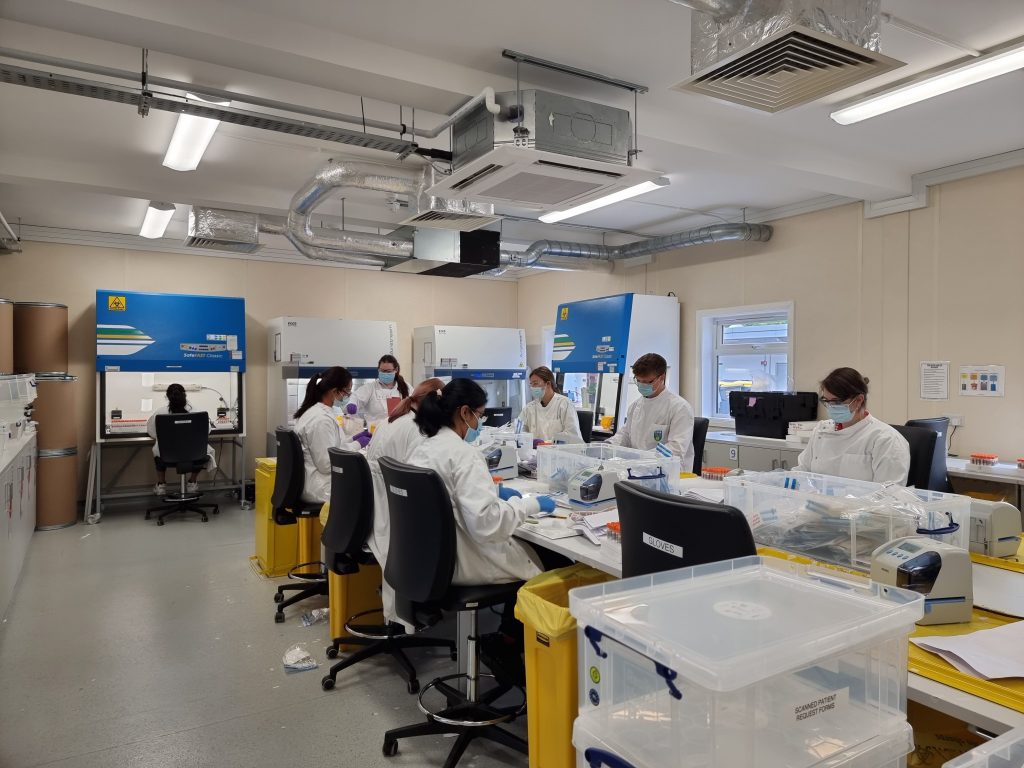 The NVRL was established at University College Dublin in 1963 at the behest of the Department of Health and is a public-sector, not-for-profit, medical virology laboratory funded by the diagnostic testing that it performs on behalf of the HSE. It is the largest such laboratory in Ireland and has played an important part in Ireland’s national pandemic response. The NVRL was established at University College Dublin in 1963 at the behest of the Department of Health and is a public-sector, not-for-profit, medical virology laboratory funded by the diagnostic testing that it performs on behalf of the HSE. It is the largest such laboratory in Ireland and has played an important part in Ireland’s national pandemic response.
Results from the NVRL’s SARS-CoV-2 RNA testing are fed back both to the HSE, which uses them to keep the public updated on the spread of the disease, and to the public health experts running Ireland’s test and trace programme.
In order to expand PCR testing capacity within the public sector, with the support of the HSE and the Department of Agriculture Food and the Marine (DAFM), the NVRL established a satellite laboratory at the DAFM at Backweston Laboratory Campus in County Kildare.
As a result, since March, NSLB has done all of the NVRL’s Covid-19 testing, so its main laboratory in Dublin can focus on non-Covid testing.
Brian O’Grady, NVRL systems manager, said: “As the volume of PCR testing increased, MSC and CliniSys did a lot of work on our existing LIMS to help it to cope with the pressure. They kept it up and running but it was obvious that we needed a new system.
“As soon as WinPath Enterprise was in place, we noticed that people were being notified of results quicker. In some cases, it’s only an hour, but that’s still a benefit for the people who need them.”
The NVRL has been using the WinPath LIMS for 30 years. The contract for WinPath Enterprise was signed in January 2021, with NSLB going live in the middle of July 2021.
Deirdre Burke, NVRL manager, said: “The biggest challenge was to move over from one system to another without a break in service, because we had to be able to keep feeding data into the testing system. We were running tests on one system over night and then we switched to the new system the next day.
“It all had to be done remotely, but we had a Microsoft Teams channel open all day for support, and that worked very well. Now, we want to start planning the next steps. The NVRL main lab will definitely move over to Enterprise in the coming months.”
WinPath Enterprise is designed to support laboratory networks. It offers superior integration capabilities, a better security architecture, and more up-to-date workflows than its predecessor.
As it happens, WinPath was not affected by the ransomware attack that impacted many Irish healthcare systems this summer. However, the extra security features of WinPath Enterprise were an additional factor in NVRL’s decision to move onto the new system.
Michael Lawlor, Clinical IT support manager at Medical Supply Company, said: “The new system supports networked laboratories and confirms the NVRL as Ireland’s hub for all virology testing, integration, and exchange of clinical patient data.
“With the support of the HSE, the NVRL decided to make the move to WinPath Enterprise and the timescale in which they have done that has been amazing. They really put their heart and soul into the move supported by MSC and CliniSys’ deployment team.
“Even though they were incredibly busy, we’re delighted to see that they are already reaping the benefits. Moving to WinPath Enterprise has future-proofed the testing system and improved security. It is a move that is helping in a lot of ways.”

Professor Tim Crook has today joined the editorial board of the Government and Public Sector Journal.
Tim has been a journalist, broadcaster, academic, and author for over four decades and during that time has campaigned for freedom of expression and journalism rights in the British legal system. He’s combined his career with teaching/training journalism and broadcasting in Higher Education and is currently Emeritus Professor in Media Communications & Cultural Studies at Goldsmiths, University of London.
Tim is also the President of The Chartered Institute of Journalists (CIoJ) and PPB Chairman.
GPSJ editor, Stuart Littleford, said: “This is brilliant news that Tim has today joined the journal’s editorial board.
“Tim brings with him an enormous amount of experience and is in the very top tier of professional journalism and media in the UK.
“His publications are regarded as the gold standard within the industry and I look forward to us working together on many topical issues in the journal.”
SolarWinds IT Trends Report 2021: Building a Secure Future examines how technology professionals perceive the evolving state of risk in today’s business environment following internal impact of COVID-19 IT policies and exposure to external breaches
SolarWinds introduces Secure by Design program as a guide for industry-wide approach to help prevent future cyberattacks
SolarWinds (NYSE:SWI), a leading provider of simple, powerful, and secure IT management software, today released the findings of its eighth annual IT Trends Report. This year’s report, SolarWinds® IT Trends Report 2021: Building a Secure Future, released eight months after the broad and highly sophisticated SUNBURST cyberattack, is part of the company’s commitment to leading industry collaboration and transparency to prevent future cyberattacks and help technology professionals navigate the new threat landscape. It examines how technology professionals perceive their organisations’ risk management and mitigation readiness after a year of rapid transformation fueled by the global pandemic. The study analyses the state of risk within the IT industry today and provides guidance on workplace strategy, tool sets, preparedness, and leadership for companies as they work to construct an organisation built to withstand risk.
Over the past year, tech pros were tasked with enabling a distributed global workforce and managing the adoption of public cloud services, as organisations quickly pivoted to implement a range of technologies to keep their businesses up and running during the pandemic. Against this backdrop, nearly every industry was confronted with the acceleration of high-level cybersecurity breaches, which highlighted the potential risk of incomplete security policies and procedures across the industry. This unprecedented upheaval has served as a critical catalyst for a broader exploration of organisations’ exposure to enterprise IT risk of all kinds—including risk introduced by the implications of remote, distributed work—and the degree to which organisations are prepared to manage, mitigate, and prevent risk in the future.
The findings of the SolarWinds IT Trends Report 2021 uncover a reality in which exposure to enterprise IT risk is common across organisations but perceptions of apathy and complacency surrounding risk preparedness are high as businesses exit a year of pandemic-driven “crisis mode.” Tech pros have outlined key areas of technology investment and upskilling to prioritise AI/machine learning and automation—demonstrating an inherent awareness that falling behind is potentially the greatest risk of all. This year’s study reveals the immense opportunity ahead for tech pros and IT leadership to align and collaborate on priorities and policies to best position not only individual organisations but the industry at large to succeed with a future built for risk preparedness.
“Technology professionals today are under even greater pressure to ensure optimised, secure performance for remote workforces while facing limited time and resources for personnel training. When it comes to risk management and mitigation, prioritising intentional investments in technology solutions that meet business needs is critical,” said Sudhakar Ramakrishna, President and CEO, SolarWinds. “More than ever before, tech pros must partner closely with business leaders to ensure they have the resources and headcount necessary to proactively address security risks. And more importantly, tech pros should constantly assess their risk management, mitigation, and protocols to avoid falling into complacency and being ‘blind’ to risk.”
2021 Key Findings
SolarWinds IT Trends Report 2021: Building a Secure Future explores how tech pros perceive the state of risk in today’s business environment, and how the global pandemic impacted technology investments across IT teams. Key findings show:
Security threats associated with external breaches and the internal impact of COVID-19 IT policies emerged as the leading macro trends influencing enterprise IT risk today.
- 33% of overall tech pro respondents state their organisations have had medium exposure to enterprise IT risk over the past 12 months.
- Security breaches are perceived to be the biggest external factor influencing an organisation’s risk exposure, with 23% of tech pros surveyed citing external security threats – like cyberattacks – as the top macro trend influencing their organisations’ risk exposure.
- However, COVID-19 also had a critical impact on organisations’ risk exposure, with tech pros flagging these top associated risk-inducing factors:
- Distributed workforce/employee relocation (18%)
- Remote work policies (18%)
- Exponential growth of data as a result of new WFH needs (15%)
- Likewise, 15% of tech pros surveyed said the accelerated shift to remote working was one of the top aspects of current IT environments considered to increase an organisation’s risk exposure, as well as incomplete or inadequate security policies (13%).
- 40% of respondents say security and compliance ranked in the top three technologies most critical to managing/mitigating risk within their organisations, followed by artificial intelligence (AI)/machine learning (35%) and network infrastructure, automation, DBaaS solutions, and ITSM and/or ITAM solutions (25%, respectively).
- Although external security threats are a leading risk factor, internal vulnerabilities as a result of remote/distributed environments cannot be overlooked in today’s work landscape.
Surveyed tech pros are confident in their risk management and mitigation preparedness strategies although enterprise IT risk exists within their organisations.
- 76% of tech pros surveyed “agree” or “strongly agree” their IT organisations are prepared to manage, mitigate, and resolve risk factor-related issues due to the policies and/or procedures they already have in place.
- This finding is echoed by organisations’ careful approach to technology adoption and implementations in response to shifting demands of COVID-19 distributed work environments: despite the accelerated timeline, 55% of respondents said standard or heightened risk management protocols were followed.
- That said, as detailed in a recent McKinsey report, tech pros and their IT organisations must be careful to avoid complacency in today’s ever-evolving risk landscape and be sure to refresh and strengthen their approach to risk management for the future.
While tech pros prioritise investments in AI/machine learning and automation as core technologies to help manage risk, implementation is hampered by dwindling resources and access to sufficient IT management solutions.
- 6 in 10 (63%) of tech pros surveyed “agreed” or “strongly agreed” technology is the best way for organisations to manage, mitigate, and resolve issues related to risk.
- IT teams prioritised investment in AI/machine learning and automation (18%, respectively), followed by DBaaS solutions (15%), to accommodate the unprecedented demands of COVID-19 and the shift to remote work.
- However, despite understanding technology can play a critical role in enterprise IT risk management, barriers to its adoption and implementation exist. The top three challenges when to utilising technology to mitigate and/or manage risk within organisations reported by surveyed tech pros are:
- Currently offered IT management solutions lack features/functionality to meet tech pro needs (48%)
- Lack of IT management solutions/tools available within organisation (40%)
- Poor management/lack of direction (40%)
- Implementation is further hampered by 40% of surveyed tech pros admitting that while some of their monitoring/management tools are integrated to enhance visibility across their IT environment(s)—whether on-premises, cloud-based, or hybrid—other tools are still siloed.
- Tech pros are overcoming these barriers by:
- Improving alignment between IT business goals and company leadership (35%)
- Developing policies and processes (28%)
Tech pros are capitalising on an opportunity to foster greater alignment and collaboration with senior leaders who will best position their organisations to manage and mitigate risks in the future.
- 48% of respondents are confident or extremely confident their IT organisations will continue to invest in risk management/mitigation technologies over the next three years.
- 48% perceive their organisation’s senior leaders or decision-makers to have a heightened awareness of risk exposure, believing it’s not “if” but “when” they will be impacted by a risk factor. But while 15% believe their organisation is prepared to mitigate and manage risk, 33% said their senior leaders have difficulty convincing other leaders of this reality, ultimately limiting resources to address risk.
- This reinforces how more than one-third (35%) of tech pros surveyed state their IT organisations are improving alignment between IT business goals and corporate leadership in response to other tech adoption barriers like a lack of training for IT personnel, and a lack of budget/resources.
To explore and interact with the 2021 findings, please visit the SolarWinds IT Trends Index, a dynamic web experience presenting the study’s findings by region and additional insights into the data, as well as charts, graphs, and socially shareable elements. This year’s study features an interactive component where visitors to the web experience can see how they compare to the results.
The findings of this year’s United Kingdom National Government report are based on a survey fielded in March/April 2021, which yielded responses from 40 technology practitioners, managers, directors, and senior executives from public-sector small, mid-size, and enterprise organisations. All regions studied in 2021, as reported on the SolarWinds IT Trends Index, were North America, Australia, Germany, Hong Kong, Japan, Singapore, and the United Kingdom, with 967 respondents across all geographies combined.
SolarWinds Outlines Secure by Design Principles for a More Secure Future
To address the industry-wide ramifications of the SUNBURST cyberattack and help strengthen its own security posture going forward, SolarWinds has introduced an initiative to become Secure by Design. Under this approach, SolarWinds is focused on further securing its internal environment, enhancing its product development environment, and ensuring the security and integrity of the products it delivers as it seeks to evolve into an industry-leading secure software development company.
The learnings resulting from the SUNBURST investigation have also presented an opportunity for SolarWinds to lead an industry-wide effort around transparency and collaboration, and for SolarWinds to develop a new model for secure software environments, development processes, and products. In partnership with former CISA leader Chris Krebs and former Facebook Chief Security Officer Alex Stamos (co-founders of the Krebs Stamos Group), SolarWinds is developing best practices to enhance the SolarWinds security posture and policies, while also serving as a guide for other organisations as they work to prevent future attacks. Customers, partners, and tech professionals can follow along with the SolarWinds Secure by Design blog content and join live webcasts hosted by members of the SolarWinds executive team, its Head Geeks™, customers, partners, and industry cybersecurity experts to learn more about Secure by Design best practices and learnings from the SUNBURST attack.
Additional Resources
Past SolarWinds IT Trends Reports
Connect with SolarWinds
 Tom Magner Government & Public Sector Journal is pleased to announce that Tom Magner has today joined the editorial board of the journal.
Currently, Tom works as News & Political Editor on Carers World Live (public service health and social care broadcast journalism), he is a writer, director and presenter on Carers World Investigates. He is the forensic investigator on ‘Watchdog’ and the ‘One Show’ (BBC1), as well as writer, director, producer, presenter of ‘Forensic Shorts’ (Forensic Factors TV).
In addition to his journalistic work he has also worked as a specialist scientific advisor to the broadcast media including research for and contributions on a range of technical issues including product failure, analysis & recalls.
His work has included being the on-screen forensic expert & investigator on a number of TV programmes such as Watchdog, Rogue Traders, Sky News, Really Useful Show, Working Lunch, Channel 4 News and Channel 5 News.
GPSJ editor, Stuart Littleford said: “We are delighted that Tom has kindly agreed to join the journal’s editorial board today.
“He brings a great deal of expertise and knowledge to our team and is totally committed to highlighting the crucial issues facing those working in the UK care sector, and all carers in general.
“Tom is passionate about these issues and working with him and his organisation can only benefit our readers.”
Other areas of Tom’s work include being a writer, presenter, reporter and director on the News At One, Science In Action (Thames FM), ‘Talking Point’ Debate, Buyer Beware, Cable Today (UATV) and Scene on 7 (WMTV).
 By Sascha Giese, Head Geek™ at SolarWinds By Sascha Giese, Head Geek™ at SolarWinds
IT teams across the public sector are under pressure to migrate technology infrastructure, services, and data to the cloud. Whether the objective is to deliver cost savings, performance improvements, better reliability, or a combination of benefits, the trend is well established. Increasingly, the emphasis is shifting away from “why” migrate to the cloud to “how soon can it be delivered?”
But in the rush to exploit the wide-ranging benefits of cloud adoption, it’s important to keep some key questions front of mind. For instance, are organisations in danger of missing out on better outcomes over the long term by pursuing rapid migration strategies? Are there benefits in taking a more measured, strategic route when moving to the cloud?
In many circumstances, adopting a gradual process can avoid the risks of becoming inadvertently locked into a particular approach or service provider. Instead, a strategy where cloud migration happens in manageable increments and where hybrid environments or multiple clouds are used as part of a best practice approach can more effectively fit the decision-making and funding processes seen for organisations across the public sector.
In practical terms, moving to the cloud in manageable stages can avoid the interruption that can come with a “big bang” approach where migration happens all at once. Indeed, pursuing a multi-cloud/hybrid cloud approach can also help maintain “business as usual” service for key IT systems, avoiding the need to bring infrastructure to a full stop for migration purposes.
What’s more, by taking the pressure off IT staff to migrate systems and data in a condensed time frame, organisations can help prevent mistakes and ensure nothing is being overlooked. It’s advisable, for example, to start a phased migration process with less critical workloads, taking note of any issues while migrating before moving on to more critical data.
The Benefits of Versatile Cloud Environments
For many organisations focused on cloud adoption, migrating all their software, services, and data to a single provider no longer makes practical or economic success. Instead, working with multiple cloud providers allows them to more effectively manage and expand their options and take full advantage of the capabilities and specialisms different platforms provide.
This approach also recognises every public sector setting has its own technology needs, and some cloud platforms may be better suited to meet them than others. For instance, some organisations operate at least some level of critical IT infrastructure, meaning it’s necessary to keep specific workloads on-premises even when migrating to cloud infrastructure on a more general level. By definition, a hybrid cloud solution opens up the benefits of cloud while alongside an existing on-prem environment. This also makes migration easier, as some workloads can remain on-premises for the long term while simultaneously shifting others to the cloud.
With any cloud migration project, preparation is key, and failing to follow a manageable process is often the single biggest obstacle to a successful approach. Preparation should always include training everyone involved in the cloud migration process, so they understand the technology, the steps involved in moving legacy systems to the cloud, and their specific role.
Some IT teams find it useful to familiarise staff with the migration process by focusing on smaller tasks before dealing with more important and ambitious steps. This not only helps minimise the risk of problems occurring during the process, but also builds experience in what it means to adopt the cloud.
Ultimately, following a well-planned timetable can deliver huge benefits over the course of a cloud migration strategy. In particular, by focusing on the overall objectives around any new multi-cloud or hybrid cloud environment and ensuring the proper training is available, it becomes more practical to focus on a best practise approach to help deliver the performance, versatility, and cost advantages of the cloud for every stakeholder.
UK Schools were closed to all but key worker children on 5 January 2021 in response to COVID-19 – and re-opened on 8 March 2021. As schools re-open, and teachers adjust to their post-covid teaching jobs, Reuters reveals that the British government has pledged a £700m support package to help primary and secondary schoolchildren to catch up on their studies.
‘Recovery Premium’
The Department for Education also pledged to introduce a ‘Recovery Premium’ to assist disadvantaged students, alongside other measures. This is to tackle concerns that those from poorer backgrounds will particularly be affected and be falling behind.
“Our package of measures will deliver vital support to the children and young people who need it most, making sure everyone has the same opportunity to fulfil their potential no matter their background,” says Gavin Williamson – the Secretary of State for Education.
Click here to read the full article.
Mark Siswick, Executive Headteacher of Chesterton Primary School, in south London, and co-founder of the Wandle Learning Trust, was honoured for services to education in the New Year’s Honours list by being awarded an MBE. The Northern Echo writes: “During the pandemic, he helped to create a national home learning programme, filming more than 100 lessons in phonics and reading to try and stop youngsters from falling behind.”
His founding of the Wandle Learning Trust was to him one of is most exciting achievements, and it’s one for which he deserves national recognition. About a decade ago he and his colleagues worked in partnership with a local secondary school, Chestnut Grove Academy. He exclaims that together they have done some great pieces of work. Chestnut Grove became an academy around 2012, and the two schools formed a trust in 2017. The foundations of which were their strong partnership.
Click here to read the full article.
|
NEED AN UP TO DATE DATABASE? 
|







 Timescales
Timescales




 However, the PRSB is also looking at how it can include NHS providers, to create a “gravitational pull” for making open standards a requirement in systems procurements and deployments.
However, the PRSB is also looking at how it can include NHS providers, to create a “gravitational pull” for making open standards a requirement in systems procurements and deployments. Scott MacIndeor,
Scott MacIndeor, 
 The economic value is the difference between costs and benefits. Applying a framework to a data related initiative is often difficult. In commercial settings, it can be achieved through testing e.g. make data available to sales team ‘A’ through a new BI platform but not to sales team ‘B’ — measure the difference in performance and you have a measure of value returned for your investment.
The economic value is the difference between costs and benefits. Applying a framework to a data related initiative is often difficult. In commercial settings, it can be achieved through testing e.g. make data available to sales team ‘A’ through a new BI platform but not to sales team ‘B’ — measure the difference in performance and you have a measure of value returned for your investment. Newham Borough Council is a vibrant Council bordering the City of London, most of its residents are from ethnic minority backgrounds and cumulatively speak more than 100 languages. Newham’s leadership team is constantly looking for ways to provide the best for its citizens. Introducing intelligent chatbots to its parking customer service offering is an important example of how the council is making a difference through technology.
Newham Borough Council is a vibrant Council bordering the City of London, most of its residents are from ethnic minority backgrounds and cumulatively speak more than 100 languages. Newham’s leadership team is constantly looking for ways to provide the best for its citizens. Introducing intelligent chatbots to its parking customer service offering is an important example of how the council is making a difference through technology. Unity by Armour works in conjunction with Armour Mobile extending its secure collaboration capabilities with secure video conferencing calls (pre-defined or on-the-fly), screen sharing and integration with secure chat groups, in addition to the existing one-to-one secure audio and video calling, and interconnectivity with trusted unified communications systems. Unity by Armour provides picture in picture and multiple screens, and offers a familiar video conferencing interface, making it easy and intuitive to use. Unity by Armour is available with a choice of hosting options, including on-premises installation, ensuring that communities are controlled by invitation-only, increasing security and guarding against ‘zoom-bombing’.
Unity by Armour works in conjunction with Armour Mobile extending its secure collaboration capabilities with secure video conferencing calls (pre-defined or on-the-fly), screen sharing and integration with secure chat groups, in addition to the existing one-to-one secure audio and video calling, and interconnectivity with trusted unified communications systems. Unity by Armour provides picture in picture and multiple screens, and offers a familiar video conferencing interface, making it easy and intuitive to use. Unity by Armour is available with a choice of hosting options, including on-premises installation, ensuring that communities are controlled by invitation-only, increasing security and guarding against ‘zoom-bombing’.
 Armour Mobile runs on Bittium’s Tough Mobile™ 2 series of ruggedised and secure smartphones ensuring voice and video conversations, and the associated files and attachments, stay completely private, no matter how hostile the environment. In addition, Bittium Secure Suite provides additional capabilities such as mobile VPN, device and application management, remote attestation and other functions.
Armour Mobile runs on Bittium’s Tough Mobile™ 2 series of ruggedised and secure smartphones ensuring voice and video conversations, and the associated files and attachments, stay completely private, no matter how hostile the environment. In addition, Bittium Secure Suite provides additional capabilities such as mobile VPN, device and application management, remote attestation and other functions.



 By Sascha Giese, Head Geek™ at
By Sascha Giese, Head Geek™ at 



 While all of these interpretations are correct, they only scratch the surface.
While all of these interpretations are correct, they only scratch the surface.
 The NVRL was established at University College Dublin in 1963 at the behest of the Department of Health and is a public-sector, not-for-profit, medical virology laboratory funded by the diagnostic testing that it performs on behalf of the HSE. It is the largest such laboratory in Ireland and has played an important part in Ireland’s national pandemic response.
The NVRL was established at University College Dublin in 1963 at the behest of the Department of Health and is a public-sector, not-for-profit, medical virology laboratory funded by the diagnostic testing that it performs on behalf of the HSE. It is the largest such laboratory in Ireland and has played an important part in Ireland’s national pandemic response.






Recent Comments